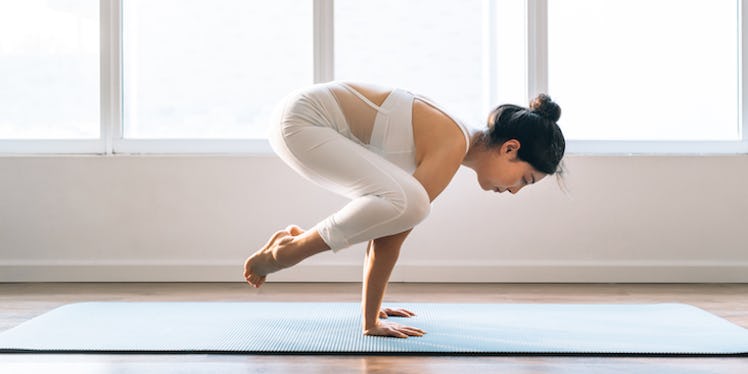
The Most Common Yoga Injuries Can Easily Be Avoided, As Long As You Do These 5 Things
As yoga has grown in popularity, so have yoga injuries, naturally. People are constantly trying to achieve the challenging and impressive asanas that they see on social media, and it's easy to forget that the ancient practice of yoga is about so much more than contorting your body into unique physical shapes. Even in the simplest of supervised beginner classes, all yogis are still at risk of developing some of the most common yoga injuries. In reality, with any physical activity always comes the potential to get hurt.
But, as a yoga teacher, I don't want to send out the wrong message and instill a fear of injury in people who are interested in experimenting with the practice. Yoga is such an incredible form of movement that is truly meant to heal your entire being. If you listen to your body, and you take care to not push your limits to a point where things get too uncomfortable, you can easily avoid getting injured during your time on the mat.
There's a quote by B.K.S. Iyengar, one of the most highly respected yoga teachers in the world, that says, "The pose begins when you want to leave it." And while it's true that yoga teaches you how to tolerate the uncomfortable (both mentally and physically), you know your body best. If anything ever feels like it's not serving you, or doing more harm than good, it's important to honor those physical cues telling you to back off. Your body is truly one of your greatest teachers, and listening to it is imperative.
Remember, though, overuse, strain, and irritation happens to everyone, even if you've been practicing yoga for years, and even if you're listening to your body's every cue. Of course, being overly cautious 24/7 squeezes out the joy of movement, and it just isn't realistic, but knowledge is key to preventing injuries. Here are five of the most common yoga injuries, and how you can avoid them each time you roll out your mat.
01Wrist Pain
Wrist pain is really common in yoga, but if it's ignored, it can actually lead to more serious strains, sprains, or even breaks.
The irritation of the wrist joint mostly comes from doing downward dog improperly, since it's a pose returned to so frequently throughout most yoga flows. Most people simply aren't used to being on their wrists so much, so it's a shock to the delicate joint that connects the hand to the forearm.
To avoid wrist pain, make sure you spread your fingers wide on your mat, like starfish, so that you have more surface area in your palms for support.
If you're suffering a wrist injury, try to avoid intense weight-bearing on your hands during a yoga class, and if you still want to do your down dogs, try making fists with your hands and putting weight on your knuckles instead of your wrists.
02Hamstring Tears And Pulls
Most people suffer from tight hamstrings as a result of too much sitting, and then, when they come to yoga, they complain that they can't touch their toes for the life of them.
However, hamstring injuries often occur when you start trying to increase flexibility in this part of the body, without taking into consideration just how weak those muscles might initially be. Tight and weak hamstrings can lead to tears and pulls when you overstretch them.
It's important to build a foundation of strength in your legs before you start really zoning in on flexibility. In your yoga practice, be sure to balance your forward folds with a sturdy and strong chair pose. Engage your glutes before you open your hips, and above all, be sure not to force any uncomfortable movements during your practice.
03Lower Back Injury
You might not be thinking about your lower back all that much while you're doing a seated or standing forward fold, but it's important to pay attention to your spine, and make sure you're not rounding it, to avoid injury. Be sure to lengthen your spine with each inhale, and fold with each exhale.
Another cause of lower back strain is forcing backbends, or doing them incorrectly if you don't have the proper guidance. When you're in wheel pose, for example, pretend like you're squeezing an imaginary block (or an actual yoga block) between your knees. If your knees splay out, it can cause compression in your lower back and lead to irritation and more serious injury.
Back-strengthening asanas are also important in balancing out deeper and more flexibility-focused backbends.
04Elbow Irritation
It's easy to splay out your elbows during the recurring chaturangas in your favorite yoga class, and you might be doing this for years without even realizing that it's wrong. (It's pretty hard even for an instructor to spot and correct!)
Make sure you hug your elbows into your side body to avoid irritation and injury to your elbow joints. Yes, it will be a lot more difficult to do it this way, but as you practice, it will become much easier, and your elbows will thank you!
05Neck Pain
If you're a first-timer with inversions (specifically headstands), it's important to be wary of putting too much pressure on your neck. This injury is no joke, and it can take a while to heal if you're not mindful.
Make sure to put the majority of your weight on your arms and shoulders in headstand; you should essentially feel nothing in your neck at all when you're upside down. To prepare for inverted moves, be sure to practice arm- and shoulder-strengthening exercises, and try having an experienced yogi or teacher nearby to spot you if you don't feel confident enough to go solo yet.
Namaste, and be safe out there!